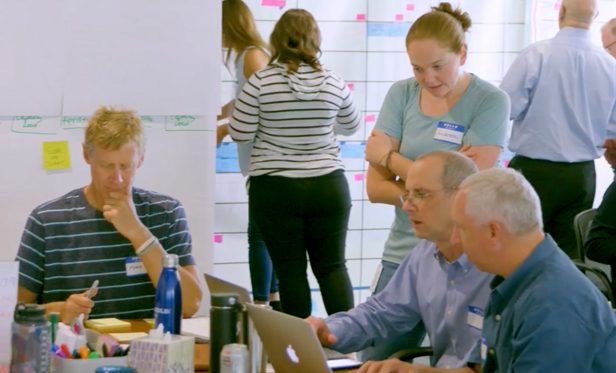
What if you could see a great example of SAFe® in the wild; a vision of a possible future as you prepare to launch your first ART? Would you want to stand in the middle of where the work is done and gain insights into what could inhibit your success? I’d like to share an approach I’ve used to leverage the power of a Gemba walk. I believe it to be one of the most powerful accelerators available for those considering implementing SAFe.
What is Gemba?
Gemba is a Japanese term that means “the real place.” It represents going to where the work is done or the place where value is created from a Lean-Agile perspective. Within an automotive plant, it’s the manufacturing floor, at a hospital, it could be the ER or operating room, and in the U.S. Government, it could be inside a Sensitive Compartmented Information Facility (SCIF).
Traditionally, a leader would take a Gemba walk to visit where the work is being done to observe the value being created and interact with the people and processes. Together, they can identify opportunities for improvement. Within SAFe, Gemba walks are among the collaborative research techniques product management will use for continuous exploration.
I encourage enterprise executives, Lean Portfolio Management executives, and ART stakeholders to take Gemba walks of PI Planning from a relentless improvement perspective. Gemba walks to allow them to truly understand the Framework while raising awareness of systemic issues that may require senior leadership assistance. Even before you’ve launched your ART, a Gemba walk of PI Planning is valuable. It is similar to someone looking to invest in a restaurant franchise who visits an existing location to get a closer look at what might be ahead of them.
While I have used this within large corporations, I have found it particularly applicable to the federal government. Many of the corporation-to-corporation or even business-unit-to-business-unit challenges that exist in the private sector do not apply as civil servant leaders are, ultimately, all part of the same overall entity. I’ve seen an incredible willingness for government leaders to share with others across agencies, such as the USAF/US Army program leader inviting NASA leaders to observe PI Planning before their ART launch. In this case, “the real place” is a live PI Planning event for an established ART.
Doing a Gemba Walk at PI Planning
As you can imagine, observing PI Planning before attempting to launch your ART will always provide valuable insights. Even if you only glean some examples of things you might do differently, there is no substitute for actually experiencing a live event.
I recommend you find the best example of SAFe you can and arrange to observe it with an experienced tour guide.
Tip: Look for ARTs organized around value, with dedicated Agile teams that meet the commitments they make themselves. If you can, find an ART where the Business Owners, Product Management, System Architect, and RTE have cleared their schedules to be 100-percent available during the entire event. Seek an ART where leaders demonstrate Lean, Agile, and SAFe values in how they work while genuinely seeking to cultivate transparency, create alignment, and deliver value together.
Interested? Here are the steps I like to take:
1. Find an ART that represents the type of SAFe implementation you hope to achieve yourself. Starting with the practices alone can still bring value, as not every company, business unit, or government program is ready to weave the values and principles necessary for great success. Additionally, some see SAFe as a process to be implemented by the numbers, pushing practices out, and directing how everything will work. Others understand that implementing SAFe, or any scaling agile framework requires shifts in mindsets and people making decisions based on new values and principles. I focus on the latter, as it’s the one that creates the deep roots needed to sustain and grow.
2. Obtain permission from the program leaders, understand what values they seek from experience, and address any concerns. Often, this idea of a Gemba walk is part of the introduction email between leaders of both programs.
3. Facilitate an orientation meeting before the planning event. This orientation allows you to introduce leaders from both programs, review the host ART’s schedule, and set the working agreements to ensure minimal disruption and maximum learning. Additionally, this meeting allows the host to share any context-specific ways they have leveraged the Framework. The visitors and the tour guide will understand the reasons for the changes before observing the event.
Tip: If remote, provide an overview of the tooling and methods used to replicate the deep collaboration model present in a face-to-face event.

4. Arrange for a dedicated tour guide who doesn’t need to facilitate the actual PI Planning event. If they have an SPC, as well as experience coaching ART launches, I recommend that the new program’s coach be the guide. Otherwise, the existing coach from the host program is a solid choice. The purpose of the tour guide is to help the visitors connect their knowledge to the field experience while highlighting best practices and answering questions in real-time without disrupting the host ART’s event. Ensure that everyone stays connected by having a persistent chat channel available for coaches and visitors throughout the event, and pre and post syncs to reflect on the insights gained.
Tip: If you consider bringing in an SPC as a coach or consultant, deeply explore their field experience. You might even find one who has a previous customer willing to share their perspective or allow you to observe their PI Planning event.
5. Allow visitors to observe the entire PI Planning event. If this isn’t feasible, see how many of the key events are available, such as opening briefings, team breakouts, plan reviews, management review, ROAMing of program risks, and the confidence vote. Understanding the host’s parameters and the visitor’s role can help you prioritize if time is limited.
6. Facilitate daily meet-afters between both sets of leaders. Standing meet-afters provide a safe forum to ask tough questions and discuss sensitive topics with honesty. Those who have the experience can share their tips and tricks with those preparing to embark on their SAFe journey.
7. Encourage connections between each visitor and the individual in their corresponding ART role. Personal relationships create an opportunity for those in the various roles to connect beyond the event. These introductions also can spark the creation of role-specific communities of practice.
Remember: SAFe is a framework, and while some essential elements, patterns, and practices lead to success, it is not one size fits all. As you look to customize your implementation, understanding why the methods are in place and which values and principles power them will serve you well.
A Gemba walk is one of the best ways to turn your knowledge of PI Planning into real understanding. It provides insights for hosts and visitors alike while creating community connections that foster alignment, transparency, quality, and execution.
Gemba resources
If you would like to learn more about Gemba within the Framework, check out the Continuous Exploration article. If you want to take a deeper dive, Jim Womack’s book, Gemba Walks Expanded, 2nd Edition is a great resource, and you can connect with one of the SAFe Fellows through the “Ask an Expert” forum on the SAFe Community Platform portal (login required).
About Phil Gardiner

Phil Gardiner, a SPCT, is focused on enabling people to achieve sustainable success through greater business agility. He has served various markets from Fortune 10 corporations to the U.S. federal government.
Share:
Back to: All Blog Posts
Next: Uncovering Your Organization’s Hidden Learning Networks